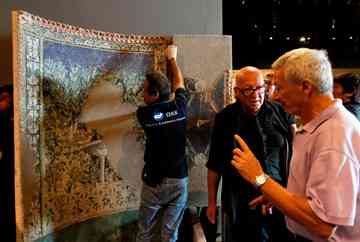The National Museum of Singapore transports visitors back 2000 years in time to experience life and death in the ancient Roman Empire. A new exhibition, Pompeii: Life in a Roman Village 79 CE reveals daily life in a city steeped in legend and mystery.
 Pompeii and its neighboring cities were buried—and frozen in time—after the fateful eruption of Mt. Vesuvius on August 24, 79 CE. After being forgotten for nearly 1700 years, the city was accidentally rediscovered by well-digging shepherds in 1748. Since then, its excavation has yielded extraordinary artifacts—from the rarest of art objects to the most common trinkets of daily use—and provided a comprehensive portrait of the life of a city at the height of the Roman Empire.
Pompeii and its neighboring cities were buried—and frozen in time—after the fateful eruption of Mt. Vesuvius on August 24, 79 CE. After being forgotten for nearly 1700 years, the city was accidentally rediscovered by well-digging shepherds in 1748. Since then, its excavation has yielded extraordinary artifacts—from the rarest of art objects to the most common trinkets of daily use—and provided a comprehensive portrait of the life of a city at the height of the Roman Empire.
Amazingly, archaeologists have also been able to piece together the final moments of the people of Pompeii. By pouring plaster into cavities in the volcanic ash left by the victims’ bodies, archaeologists were able to create molds of the final moments of life in this once-thriving seaport. Pompeii: Life in a Roman Village 79 CE features more than 250 artifacts uncovered from beneath 30 feet of volcanic material in this once-cosmopolitan city. The exhibition brings these priceless artifacts, along with body casts of eight of the victims of Vesuvius’ fury, to Singapore.
Many of the artifacts have never been on public display before 2007, including a stunning large-scale garden fresco, gold coins, jewelry, marble and bronze statuary, and other dazzling examples of ancient Rome’s artistry and craftsmanship.
The exhibition takes visitors through an average day in Pompeii; visitors walk a Pompeian street complete with storefronts and ambient sound, step into a tavern and see samples of food items carbonized by the eruption, explore a home and garden setting from Pompeii, and see how the people of Pompeii expressed their spirituality.
In addition to an extensive variety of artifacts—from beds to lanterns to hairpins to an exquisitely preserved 15-foot-long garden fresco from the House of the Gold Bracelet—A Day in Pompeii also features hands-on build-a-mosaic and build-a-Roman-arch activities.
The showpieces of the exhibition are the body casts, made from the cavities left in the ash after the bodies of those buried decomposed. These figures are caught in their last moments, shielding their faces, clinging to each other. Even a dog impression was preserved.
Source: Art Daily [October 18, 2010]